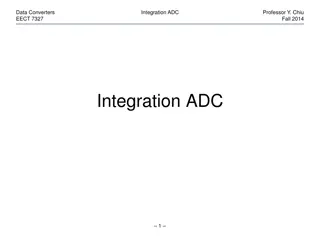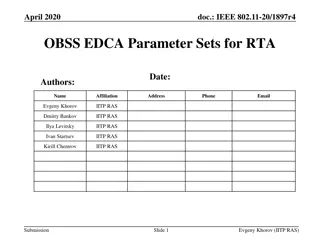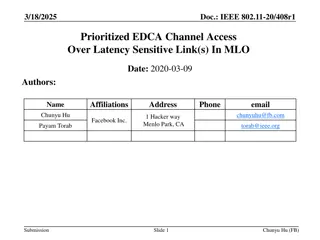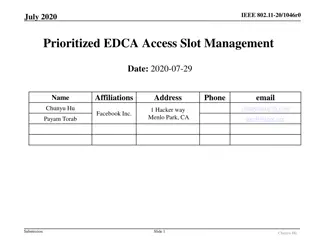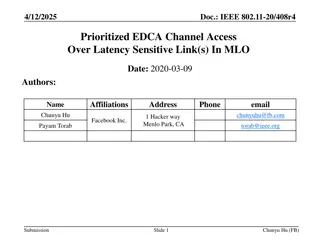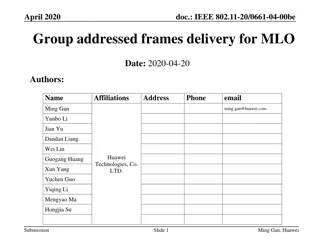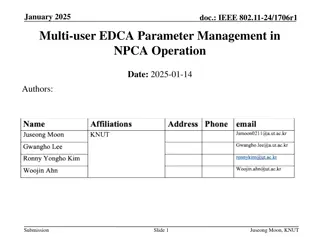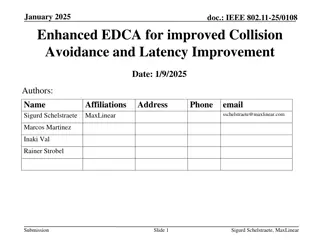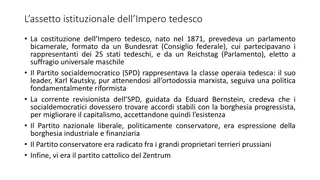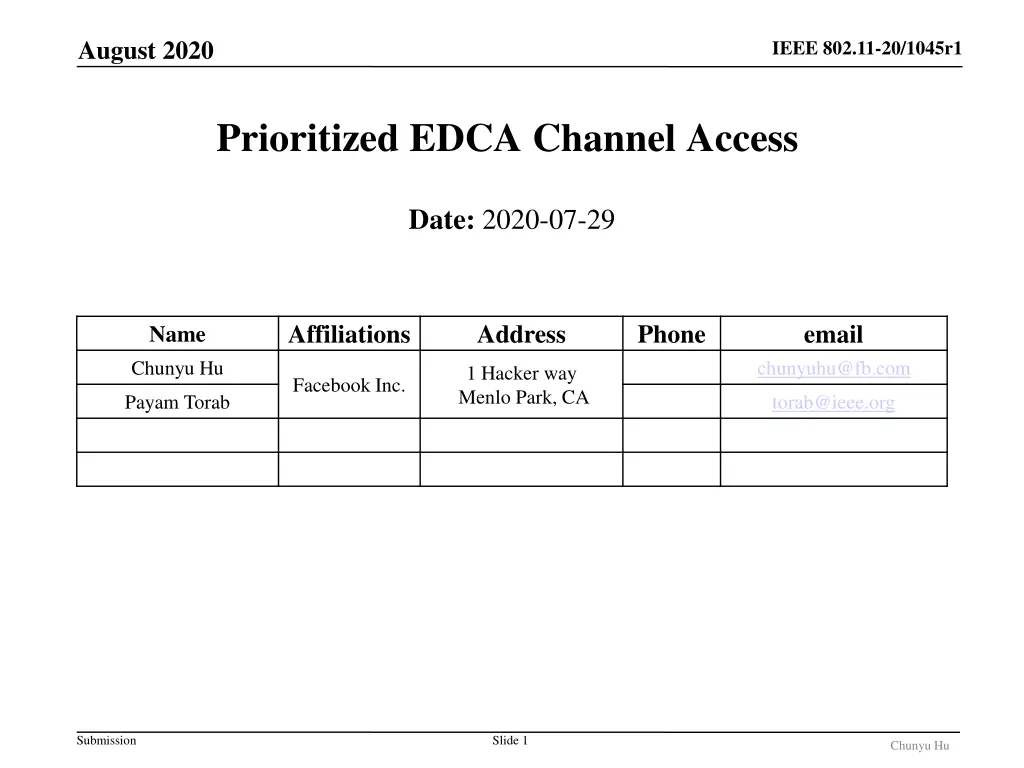
IEEE 802.11-20/1045r1 Channel Access Details
Explore the August 2020 IEEE 802.11-20/1045r1 document focusing on prioritized channel access design, time slot structure, periodicity, definitions, and more for improved medium access. Learn about slot types, interval configurations, and the potential benefits and challenges of this approach.
Download Presentation

Please find below an Image/Link to download the presentation.
The content on the website is provided AS IS for your information and personal use only. It may not be sold, licensed, or shared on other websites without obtaining consent from the author. If you encounter any issues during the download, it is possible that the publisher has removed the file from their server.
You are allowed to download the files provided on this website for personal or commercial use, subject to the condition that they are used lawfully. All files are the property of their respective owners.
The content on the website is provided AS IS for your information and personal use only. It may not be sold, licensed, or shared on other websites without obtaining consent from the author.
E N D
Presentation Transcript
August 2020 IEEE 802.11-20/1045r1 Prioritized EDCA Channel Access Date: 2020-07-29 Affiliations Address Phone email Name Chunyu Hu chunyuhu@fb.com 1 Hacker way Menlo Park, CA Facebook Inc. Payam Torab torab@ieee.org Submission Slide 1 Chunyu Hu
IEEE 802.11-20/1045r1 August 2020 Abstract Background: new medium access method to provide more predictable, and prioritized channel access (11- 20/408r6) This contribution provides more details on channel access design A follow-up contribution will focus on signaling part of the protocol. Submission Slide 2 Chunyu Hu
IEEE 802.11-20/1045r1 August 2020 Time Slot Structure The time is divided into slots of fixed, and configurable duration Ts o The duration Ts is intended to be at txop level of granularity, long enough to hold one or more data frame exchange: rts/cts/a-mpdu/ba. o Slot boundary is at time Ts, 2*Ts, ., (time satisfying (TSF % Ts) == 0) o This provides a scalable way to represent medium/schedule status and can be conveniently described using a bitmap format E.g. a service period (SP) can be represented by a consecutive number of slots AP can share medium status or schedule info in slot bitmap format Good for both intra-BSS and inter-BSS coordination Beacon Beacon Beacon Ts ... ... time SP (Service Period) Submission Slide 3 Chunyu Hu
IEEE 802.11-20/1045r1 August 2020 Periodicity The link may be able to share a common, periodic interval T, composed of fixed, and configurable number of slots. Interval boundary is at (TSF % T == 0). o Example: two periodic streams with respective intervals: 16 TUs and 14 TUs AP can use an interval of 112 TUs o Pros: Help non-AP STA to predict slot occupancy without receiving the beacon before contending for the medium Simplify the checking overlap / over-subscribing the utilization of a slot Beneficial for applications of similar characteristics o Con: not realistic/practical all the time it may require a very long bitmap. E.g. T1 = 200 TUs, T2 = 300 TUs and Ts = 1TUs. Usually it s difficult to do so if one stream has small interval and the other has large interval high/low bandwidth traffic Propose: define maximum slot bitmap size, e.g. 256 bits. If possible to derive a common period T = N * Ts with N limited to maximum size, then AP can indicate if the schedule/slot bitmap info is repetitive/persistent Submission Slide 4 Chunyu Hu
IEEE 802.11-20/1045r1 August 2020 Definitions Example where a period T is assumed: three non-AP STAs and one AP. Terms: o P-slot: a slot is called P-slot if any STA has requested AP to assign the slot for prioritized access. o R-slot: A slot is called R-slot if none of STA has requested this slot. o MP-slot: from a STA s perspective, if the slot has been assigned to this STA (there can be multiple STAs assigned to the same slot however.) o OP-slot: from a STA s perspective, it is not registered for this P-slot s membership. Submission Slide 5 Chunyu Hu
IEEE 802.11-20/1045r1 August 2020 EDCA Parameters and Terms Default EDCA parameters: used by regular traffic for channel access. A second set of EDCA parameters: used by P-traffic to access P-slots. Called P- EDCA params. Regular traffic (R-traffic) uses a backoff timer, timer-1, to access the channel. Prioritized traffic (P-traffic) uses a second backoff timer, timer-2, to access the channel during P-slots. Alternative AIFS (A-AIFS): AIFS value used by timer-1 during P-slots. Submission Slide 6 Chunyu Hu
IEEE 802.11-20/1045r1 August 2020 General Descriptions AP advertises the following parameters: o Slot duration: S TUs. E.g. , 1, 2, 4 TUs o Interval T: T = N slots o P-EDCA params o A-AIFS o Any additional TBD parameters as needed. AP advertises the above info in Beacons, Probe responses and applicable management/action frames. Each STA can request assignment of slots for DL/UL/p2p traffic. The STA can request multiple contiguous number of slots. A slot can be assigned to multiple STAs to conduct MU operation. o A group of contiguous slots forms a service period (SP). o Details of slot management are in a separate contribution. Submission Slide 7 Chunyu Hu
IEEE 802.11-20/1045r1 August 2020 Channel Access: General Principal T T Assumed P-traffic pattern: o Periodicity o Bursty: have packets ready at beginning of their MP-slots o Traffic may complete before end of current SP / a group of contiguous MP-slots and in that time period. The remaining time should allow R-traffic to access Provide P-traffic prioritized access during P-slots Handle certain range of traffic amount variants of P-traffic in each interval 1. Protect beginning of a SP: tolerate small variants of time packets being ready 2. Protect SP period when bursty P-traffic is undergoing: A-AIFS for R-traffic and default EDCA parameters 3. Release SP period automatically when bursty P-traffic completes time start In burst complete 1. 2. 3. time Submission Slide 8 Chunyu Hu
IEEE 802.11-20/1045r1 August 2020 Backoff Behavior for R-Traffic When there is no P-slots: o When no STAs register any slot at AP, that is, there is no R-slots, then regular traffic access the channel following default EDCA access using default EDCA parameters. The channel access is not different from existing EDCA behavior. When there are some P-slots: o Regular traffic is not allowed to start transmission during a time window X usec before entering the P-slot boundary, and Y usec after the boundary. Y usec X usec P P P time o If timer-1 is running, then suspend timer-1 X usec before the illustrated slot boundary, and can resume Y usec after the slot boundary. If medium is busy not due to its own transmission, then the slot is deemed as occupied (assumingly by its registered member), and the STA shall give priority to it -- to that end, until the STA successfully win the medium, it uses a newly defined A-AIFS to decide if medium has become idle and resume timer-1 counting down. Submission Slide 9 Chunyu Hu
IEEE 802.11-20/1045r1 August 2020 Backoff Behavior for Prioritized Traffic Medium access to MP-slots o In general, timer-2 is not run and is suspended out of MP-slots. When MP slots start, timer-2 resumes (or reset CW to CWmin, and generate a new backoff value from current CW. TBD). o Packets from P-traffic are transmitted using timer-2 during MP slots. If the STA doesn t have any packets from P-traffic any more, it can use timer-1 to contend medium access for its regular traffic as described in previous sections. o If the P-traffic for the current interval didn t complete when MP-slots end, the STA may still transmit them, but follows the medium access rule for regular traffic. Medium contention among STAs sharing the same SP / MP-slots o The same slot can be assigned to a) a non-AP STA for its DL and/or UL traffic, b) multiple non-AP STAs for their DL and/or UL traffic, or c) peer-to-peer transmissions. o STAs that have registered the slots membership contend medium access among themselves. To further mitigate the contention and reduce collision, the STAs can use any applicable mechanisms. For example, AP can use trigger frames to manage both DL and UL transmissions if the non-AP STA supports it. For another example, AP can use triggered P2P transmission procedure [11-20/813r6] to coordinate the peer-to-peer communication. Submission Slide 10 Chunyu Hu
IEEE 802.11-20/1045r1 August 2020 Slot Boundary (1) For regular traffic: o Regular traffic shall stop at a slot boundary when a slot transits from R-slot to P-slot. o If the regular traffic wins the medium access during P-slots, its txop shall stop at the slot boundary, unless it knows the next slot belongs to the same STA(s) as the current P-slot. AP provides additional slot bitmap info for this purpose. Submission Slide 11 Chunyu Hu
IEEE 802.11-20/1045r1 August 2020 Slot Boundary (2) For P-traffic: o When transmitted during the MP-slots, the current txop shall end at the boundary of MP OP slot. o When transmitted during the MP-slots, the current txop should end at the boundary of MP R slot, but is allowed to extend to next slot (but not beyond.) o When transmitted during R-slots, follow the regular traffic rule. Txop by P-traffic case 1 case 2 (a) (a) (a) (b) (b) (b) (c) (c) (a) (a) (a) (b) (b) (b) (c) (c) time Submission Slide 12 Chunyu Hu
IEEE 802.11-20/1045r1 August 2020 Support of Peer-to-Peer Communication The Peer-to-Peer communication can be prioritized as well Some examples of peer-to-peer links: o TDLS: either non-AP STA can request slot membership for their P-traffic, and follow corresponding channel access rules o Tethered link using P2P (GO/GC): GO as non-AP STA associated with the AP, and request slot membership for the P-traffic carried over the p2p link o Tethered link using SoftAP: similar to above Additional tools that can be used to mitigate contention and improve efficiency: o Trigger based access if SoftAP/GO supports it o Triggered P2P communication [11-20/813r6] Note: the slot assigned to the peer-to-peer communication, depending on supported frame sequence, may have to be limited to be exclusive to the peer-to-peer communication (not shared with other peer-to-peer links) Submission Slide 13 Chunyu Hu
IEEE 802.11-20/1045r1 August 2020 A Special / Simplified Configuration If all prioritized traffic falls into the following cases, then we can disable EDCA for regular traffic during P-slots completely and uses A-AIFS sensing to resume regular traffic after prioritized traffic completes. This simplifies design but sacrifices flexibility. o DL: AP transmits to associated non-AP STA o UL: AP uses trigger frame to poll UL packets o Peer-to-peer: DL : softAP/GO its associated STA(s) UL : SoftAP/GO uses trigger based for its UL traffic Use the newly defined trigger based P2P frame sequence Configuration: o Don t need a second set of EDCA parameters since all transmissions are initiated only by one designated STA. o A-AIFS: STAs with regular traffic use A-AIFS to determine if the prioritized access has completed early. o Only need existing backoff timer Submission Slide 14 Chunyu Hu
IEEE 802.11-20/1045r1 August 2020 SP #1 Do you support that the TGbe SFD shall include (in R1): o An optional mechanism of dividing medium time into slots of duration TBD during which prioritized EDCA access operates for specifically allowed STAs Submission Slide 15 Chunyu Hu
IEEE 802.11-20/1045r1 August 2020 SP #2 Do you support that the TGbe SFD shall include (in R2): o An optional mechanism of dividing medium time into slots of duration TBD during which prioritized EDCA access operates for specifically allowed STAs Submission Slide 16 Chunyu Hu
IEEE 802.11-20/1045r1 August 2020 SP #3 Do you support that the TGbe SFD shall include (in R1) a simple channel access enhancement that provides a more predictable latency performance in R1: o Define prioritized access time period assigned for specifically allowed STA(s) o AP advertises and share all such prioritized access time period in a TBD resolution o TXOP shall end before start of any prioritized access time period Submission Slide 17 Chunyu Hu







